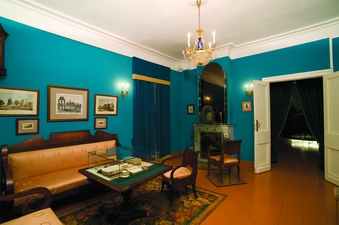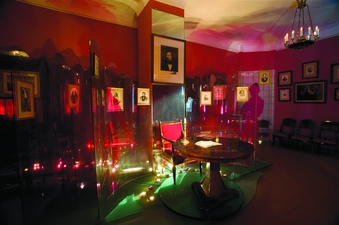Permanent Exposition
 |
 |
.jpg) |
 |
 |
 |
Photos by L. Ozyornikov, A. Shklyaruk, F. Shklyaruk
About the Museum
In the very centre of Moscow, near the Arbat Square, stands an old city mansion, with its history dating back to the 17th century. Today it is home to Russia's only museum of Nikolai Gogol. Cast-iron gates lead to the yard with Gogol's monument created by Nikolai Andreyev on the writer's 100th anniversary. On the right stands an arcaded Empire-style mansion. Here Gogol spent his last four years and died on February 21 (O.S.) of 1852. On the left stands the 'Carriage House' — the offices of the mansion. Moscow fascinated Gogol on his very first visit. In 1832 he enjoyed a warm welcome by the local society after his successful debut with "Evenings on a Farm near Dikanka". He met Yevgeny Baratynsky, Denis Davydov, Mikhail Lermontov, Ivan Turgenev, Alexander Ostrovsky, Pyotr Vyazemsky, Pyotr Chaadayev, Nikolai Ogaryov, Vladimir Sollogub, Alexey Khomyakov, and many other remarkable figures of the time.
Gogol moved to the house in 1848 on the invitation of Count Alexander Tolstoy, a noted statesman, and his wife Anna. The Tolstoys were among the few kindred-spirit friends of Gogol.
The museum's collection is presented in the ground-floor suite of rooms in the mansion's chief building. Each room accentuates a particular exhibit made into a symbolic installation: the travelling trunk in the entrance hall, the fireplace in the drawing room, the bureau in the study, and Gogol's death mask in the memory hall. The museum displays authentic historical items and works of art, as well as Gogol's belongings.
In two ground-floor rooms provided to the writer, he worked on the second volume of Dead Souls.
In the same final years, Gogol prepared a second edition of his collected works and was working on religious prose. In was in this house that Gogol burned some of his manuscripts ten days prior to his death. Visitors usually found Gogol standing and working at the high bureau or copying the manuscript at the table. It was Gogol's habit to pronounce the text he was composing, thus turning his creative process in a sort of theatrical performance.
On November 5, 1851, Gogol read The Government Inspector to the actors of the Maly Theatre.
According to the Museum scenario, the right half of the house introduces the visitor to Gogol the writer, and its left half – to Gogol the reciter.
The next floor presents Gogol's books and essays on Gogol's life and legacy. Exhibits include the portraits of the house owners, engravings, litographs depicting the writer's memorable places. One of the sheet music books in the music section may have belonged to Countess Anna Tolstaya.

